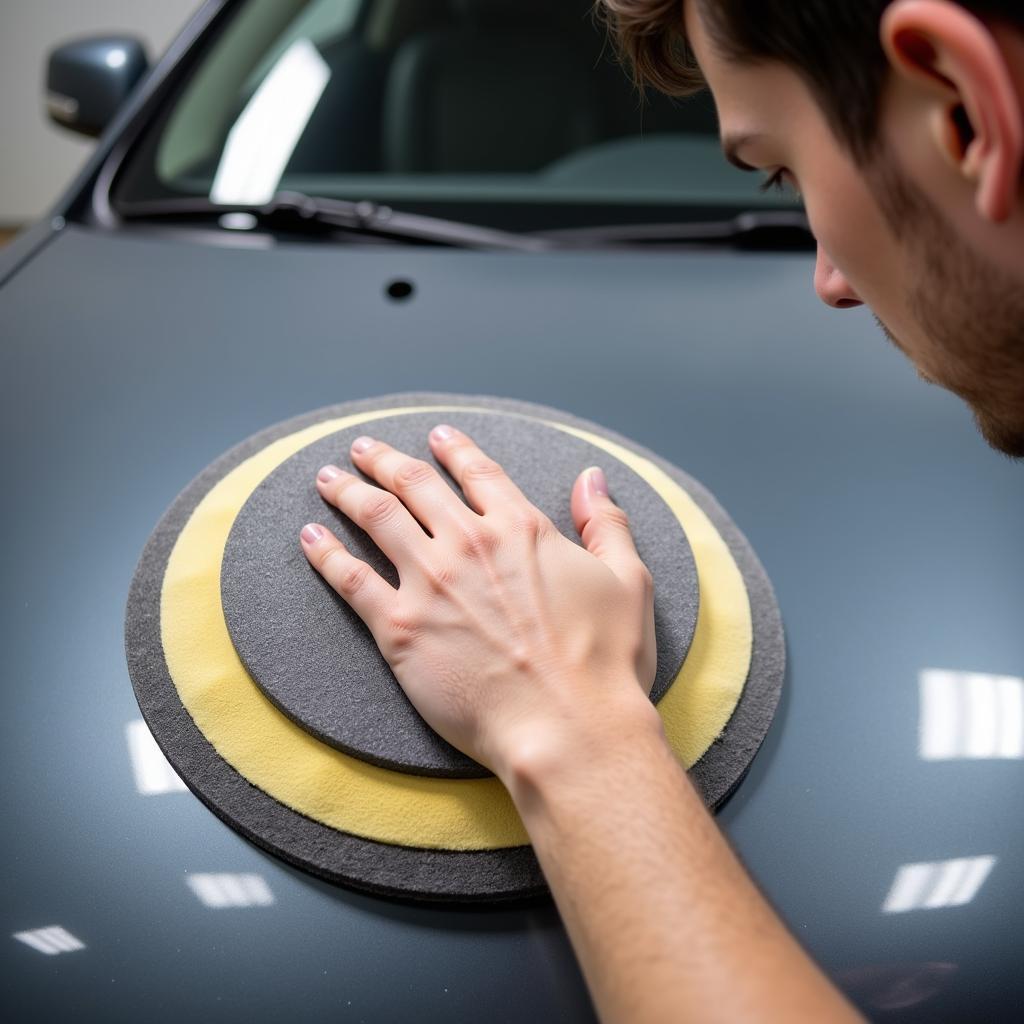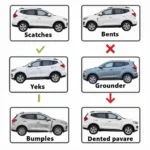Car paint repair can seem daunting, but knowing how to patch repair car paint can save you time and money. Minor scratches and chips don’t always require a full-blown professional respray. With the right tools and techniques, you can achieve impressive results from the comfort of your own garage. This guide provides a comprehensive approach to DIY car paint patch repair, offering practical advice and professional tips for a seamless finish.
Knowing how to perform a car paint patch repair not only saves you money but also helps preserve your car’s value. Learning this skill allows you to address minor paint damage promptly, preventing rust and further deterioration. car paint patch repair is a valuable skill for any car owner.
Assessing the Damage: Know Your Enemy
Before you start, carefully assess the damage. Is it a shallow scratch, a deep chip, or a scuff? The extent of the damage will determine the necessary repair approach. A light scratch might only require some polishing compound, while a deep chip will need primer and several coats of paint.
Gathering Your Supplies: Tools of the Trade
Having the right tools and materials is crucial for a successful patch repair car paint job. You’ll need sandpaper (various grits), primer, touch-up paint, clear coat, masking tape, rubbing compound, polishing compound, microfiber cloths, and wax. Investing in quality materials will significantly impact the final result.
Preparing the Area: A Clean Slate
Thoroughly clean the damaged area with soap and water, followed by a degreaser. This ensures proper adhesion of the primer and paint. Dry the area completely before proceeding. Masking the surrounding area protects the undamaged paint from accidental sanding or overspray.
Applying the Primer: Laying the Foundation
If the chip has exposed the bare metal or primer coat, apply a thin layer of automotive primer to the affected area. This provides a smooth and uniform base for the touch-up paint. Allow the primer to dry completely according to the manufacturer’s instructions.
Applying the Touch-Up Paint: The Art of Matching
Carefully apply the touch-up paint to the chipped area, using a fine-tipped brush or a touch-up pen. Apply multiple thin coats, allowing each coat to dry before applying the next. Avoid applying thick coats, which can lead to runs and unevenness. paint patch repair car requires patience and precision.
Applying the Clear Coat: The Protective Shield
Once the touch-up paint is dry, apply a thin layer of clear coat to protect the repair and restore the shine. Allow the clear coat to dry completely.
Wet Sanding and Polishing: The Finishing Touches
After the clear coat has dried, use fine-grit sandpaper (2000-grit or higher) to carefully level the repaired area with the surrounding paint. Follow up with rubbing compound and polishing compound to remove any sanding marks and achieve a smooth, glossy finish. Finally, apply a coat of wax to protect the repair and enhance the shine.
How to Repair Small Paint Patches on a Car?
Repairing small paint patches is similar to the process described above, but may not require primer. Focus on precise paint application and careful blending. how to repair small paint patches on a car can often be achieved with just touch-up paint, clear coat, and polishing compound.
What is car paint repair patches?
Car paint repair patches are small, pre-cut pieces of vinyl film designed to temporarily cover minor scratches and chips. While they offer a quick fix, they aren’t a permanent solution and may not match your car’s paint perfectly. Car paint repair patches are a useful temporary fix but not a substitute for proper repair.
 Wet Sanding Repaired Car Paint
Wet Sanding Repaired Car Paint
Conclusion
Successfully patch repairing your car paint requires patience, attention to detail, and the right materials. By following these steps, you can effectively address minor paint damage, saving money and maintaining your car’s appearance. Remember, how to patch repair car paint effectively involves careful preparation, precise application, and meticulous finishing. For deeper scratches or more complex damage, consulting a professional is always recommended.
FAQs
- Can I use any type of touch-up paint? No, it’s essential to use touch-up paint specifically formulated for your car’s make, model, and year to ensure a perfect color match.
- How long does the repair take? The entire process, including drying time, can take several hours or even a day, depending on the extent of the damage.
- Do I need to apply clear coat? Applying clear coat is highly recommended as it protects the repair, enhances the shine, and provides a more durable finish.
- Can I patch repair any type of car paint damage? While patch repair is effective for minor scratches and chips, it may not be suitable for large areas of damage or deep dents.
- What if the color doesn’t match perfectly? Slight color variations are possible. Consult a professional for color matching advice if needed.
- How can I prevent future paint damage? Regular washing and waxing, parking in shaded areas, and using paint protection film can help protect your car’s paint.
- What is the best way to find my car’s exact paint code? Your car’s paint code is usually located on a sticker inside the driver’s side doorjamb, glove compartment, or under the hood.
For further information, check out our article on patch repair car paint.
Need further help with your car repair? Contact us via WhatsApp: +1(641)206-8880 or Email: [email protected]. Our customer service team is available 24/7.


